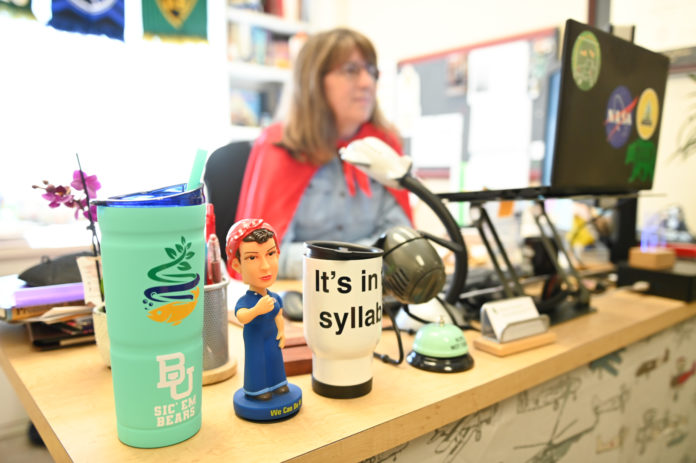
By Audrey Patterson | Reporter
Tacked onto the front door of assistant chair and clinical associate professor of mechanical engineering Dr. Anne Spence’s office is a women’s restroom sign.
The sign states, “It was never a dress,” alongside an image of the female symbol with pants and a red cape.
Spence said she loves this sign because it disrupts the stereotype of what women can and should do.
“I always find it cool to see women who do things that are not typical or what society would say is typical or even appropriate sometimes for a woman to do,” Spence said. “That’s why I want to adhere to history like the woman on the wall. [Leah Moncure] graduated with a degree in mathematics and was the first registered professional female engineer in the state of Texas. She came from Baylor, and I think that is so cool.”
Adam Weaver, clinical assistant professor of professional practice, said Spence’s office is full of interesting photos, women engineers and mementos from past experiences with the Society of Women Engineers.
“I love the NASA speed limit signs she has, which is the speed of light, because when you’re working with vehicles in outer space, obviously they’re traveling at a really high velocity, so that one is particularly interesting to me,” Weaver said.
Spence said she wants women to be able to see themselves in her space. On top of her bookshelf sit two encased Barbies — one a computer engineer and the other involved in robotics.
“Barbie can be a smart girl,” Spence said. “I think kind of disrupting this whole idea that if you’re a woman engineer, you look like this. We can all look different and still be women in engineering.”
Spence said “Rosie Revere, Engineer” is one of her favorite books on her shelf, despite it being targeted toward younger children. In fact, Spence said the book is often a gift she gives to her friends who have babies.
“What it shows is the fact that she failed and failed and failed and then was successful because that’s something that I notice in my students,” Spence said. “They don’t like to fail, and they think if they fail, it’s bad, and it’s not. You learn so much more by doing that than when you are easily successful all the time. So I think that’s just the message that I love about that book, is that she kept trying until she got it right.”
On Spence’s shelves, there are several different LEGO figures, including the cast from “The Big Bang Theory” and influential women in STEM like Margaret Hamilton, Nancy Roman, Sally Ride and Mae Jemison. Beside the LEGO women sits Spence’s favorite object in her office: a tiny plush NASA space shuttle.
Weaver said it’s nice for Baylor’s female students to see someone like Spence, who has been highly successful in this field.
“I have a lot of female students in all my classes, and it’s great to see that right,” Weaver said. “We like the diversity, and we like seeing more and more numbers of women coming in and doing STEM-type of degrees. It’s really encouraging, and it’s really fun to see that happen.”
Spence said her goal is to add more women of various backgrounds on her walls so students can not only see themselves but also see the ways other women have paved.
“We have 25% women in our engineering program, which is pretty good,” Spence said. “In most schools with mechanical and electrical, the numbers are much lower. So we do pretty well here. I want to make sure we keep doing well.”
Spence said she pursued aerospace from a young age. Her father was an engineering professor and a pilot.
“Ever since I was two, I was flying in a four-seater aircraft,” Spence said. “By the time I was eight, I was helping dad do the aircraft’s pre-flight. I mean, it was just normal. Doesn’t everybody fly in an airplane? I found out later that’s not normal.”
Spence said when she was about to get her Ph.D., she reflected on her experience as an undergraduate. She said she thought there might be more women in the classroom if there were a woman in front of the classroom; after this realization, she began teaching.
Spence said a lack of promotion is the reason why there hasn’t been a huge increase of women engineers.
“I think women think, ‘Only people who work on cars are mechanical engineers,’ where in reality, you could be designing a solar installation to collect solar power in a remote area of the world so they could have electricity,” Spence said. “You can be creating biomedical devices to support people’s healing. I think we do a bad job of saying how engineers help society.”
Spence said to help women see themselves as future engineers, Baylor could add an environmental engineering major, do better at promoting and hire more female faculty.
“I think we need to promote ourselves better,” Spence said. “As to the fact that we do have a large group of women here, you will find your sisters here, and it will be great.”





